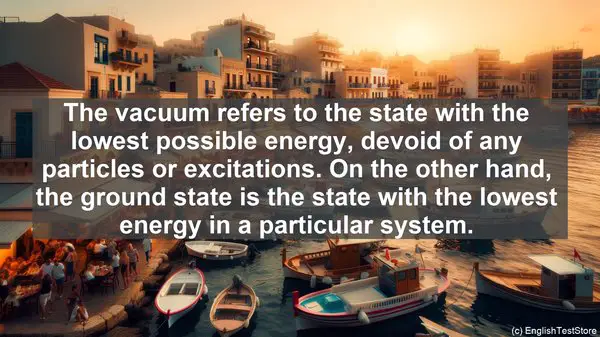Introduction
Welcome to today’s lesson. Quantum Field Theory is a fascinating subject, but it can also be quite challenging. One of the reasons for this is the presence of numerous words that are often used interchangeably, leading to confusion. In this lesson, we will explore the top 10 commonly confused words in Quantum Field Theory, providing clear definitions and examples for each. So, let’s dive in!

1. Lagrangian vs. Hamiltonian
The Lagrangian and Hamiltonian are two fundamental concepts in Quantum Field Theory. While they both describe the dynamics of a system, they do so in different ways. The Lagrangian focuses on the system’s coordinates and their time derivatives, while the Hamiltonian emphasizes the system’s energy. Understanding the distinction between these two is crucial for accurately analyzing and predicting the behavior of quantum fields.
2. Vacuum vs. Ground State
In Quantum Field Theory, the terms ‘vacuum’ and ‘ground state’ are often used interchangeably. However, they have distinct meanings. The vacuum refers to the state with the lowest possible energy, devoid of any particles or excitations. On the other hand, the ground state is the state with the lowest energy in a particular system. While the vacuum is always a ground state, not all ground states are vacuums. This distinction is essential when discussing the properties and phenomena of quantum fields.
3. Bosons vs. Fermions
Bosons and fermions are two types of elementary particles in Quantum Field Theory. The key difference between them lies in their spin. Bosons have integer spins (0, 1, 2, etc.), while fermions have half-integer spins (1/2, 3/2, 5/2, etc.). This distinction has profound implications for their behavior and interactions. For example, bosons can occupy the same quantum state, leading to phenomena like Bose-Einstein condensation, while fermions obey the Pauli exclusion principle, preventing such occupation.
4. Gauge vs. Global Symmetry
Symmetries play a crucial role in Quantum Field Theory, and two common types are gauge and global symmetries. A gauge symmetry is a local symmetry, meaning it can vary from point to point in spacetime. In contrast, a global symmetry is the same at all points. The distinction is significant because gauge symmetries give rise to gauge bosons, which mediate the fundamental forces, while global symmetries are associated with conserved quantities, such as the conservation of electric charge.
5. Perturbation Theory vs. Non-Perturbative Methods
When it comes to solving problems in Quantum Field Theory, two broad approaches are perturbation theory and non-perturbative methods. Perturbation theory involves expanding the equations of the theory in a series, assuming small interactions. This approach is effective when the interactions are weak. In contrast, non-perturbative methods aim to solve the equations exactly, even for strong interactions. Both approaches have their strengths and limitations, and the choice depends on the specific problem at hand.
6. Renormalization vs. Regularization
In Quantum Field Theory, infinities can arise in calculations, making them mathematically ill-defined. To address this issue, two techniques are commonly used: renormalization and regularization. Renormalization involves redefining certain parameters in the theory to absorb the infinities, resulting in physically meaningful predictions. Regularization, on the other hand, introduces a cutoff or a regulator to make the calculations finite. Both techniques are essential tools in Quantum Field Theory, ensuring accurate and meaningful results.
7. Scattering vs. Decays
Scattering and decays are two processes that describe the interactions of particles in Quantum Field Theory. Scattering refers to the collision of particles, resulting in their deflection or transformation. Decays, on the other hand, involve the spontaneous transformation of a particle into one or more other particles. While both processes involve the change of particles, they occur in different contexts and have distinct characteristics, necessitating separate treatments and analyses.
8. Infrared vs. Ultraviolet Divergences
Divergences are another challenge in Quantum Field Theory calculations. Two common types are infrared (IR) and ultraviolet (UV) divergences. IR divergences arise when the momenta of particles involved in a process tend to zero. UV divergences, on the other hand, occur when the momenta become infinitely large. Both types of divergences indicate the breakdown of the theory’s perturbative description and require careful handling, often through renormalization techniques.
9. Symmetry Breaking vs. Symmetry Restoration
Symmetry breaking and symmetry restoration are phenomena that can occur in Quantum Field Theory. Symmetry breaking refers to a situation where the symmetry of a system is not apparent in its ground state. This can lead to the emergence of new particles or interactions. Symmetry restoration, on the other hand, occurs when a broken symmetry is restored at high energies or temperatures. Both phenomena have profound implications for the behavior and properties of quantum fields.
10. Vacuum Fluctuations vs. Particle Creation
Quantum Field Theory predicts that even in the vacuum state, there are fluctuations and virtual particle-antiparticle pairs continuously appearing and annihilating. These are known as vacuum fluctuations. Particle creation, on the other hand, refers to the actual production of particles, often in the presence of external fields or interactions. While both processes involve the generation of particles, they have different origins and characteristics, highlighting the richness and complexity of Quantum Field Theory.

